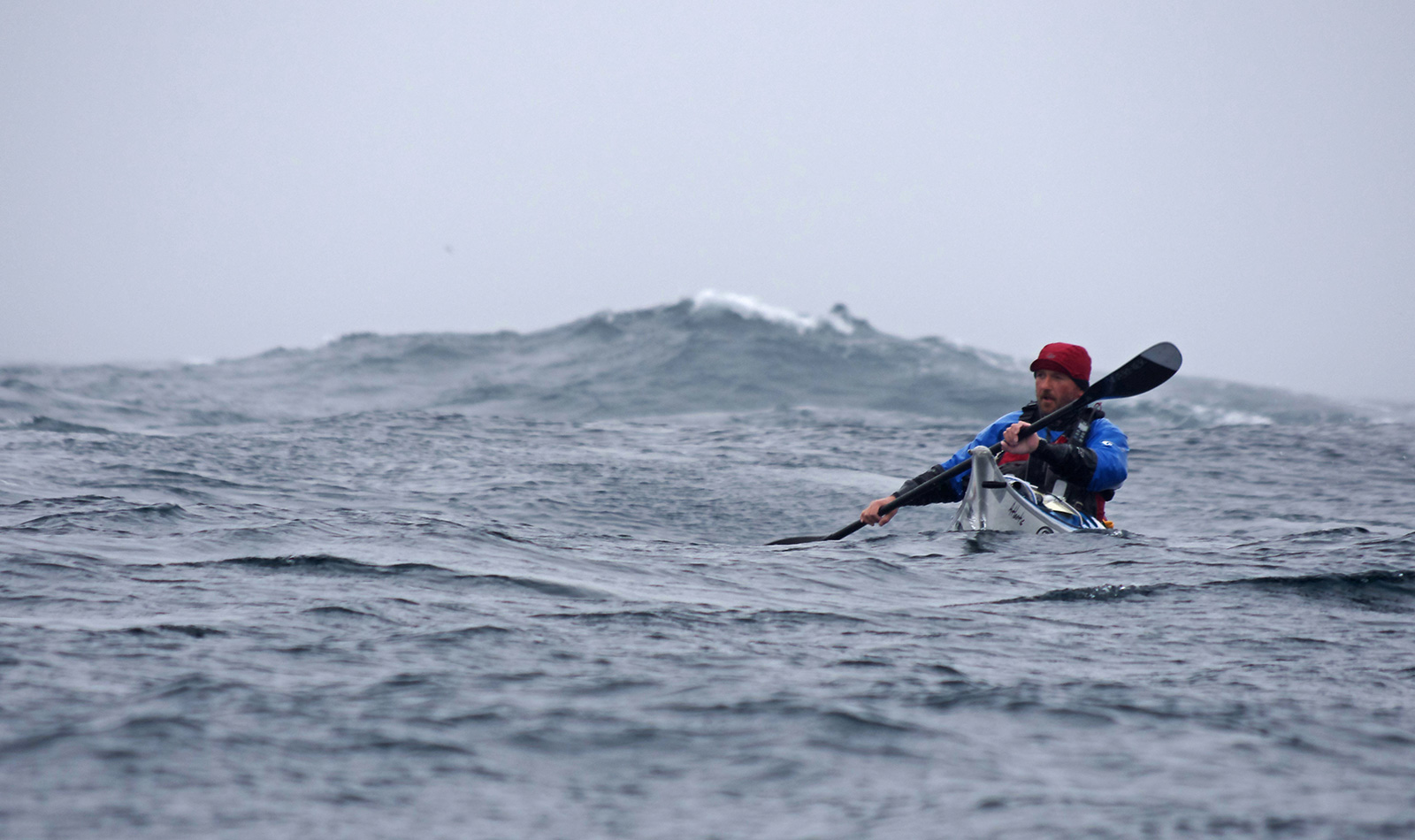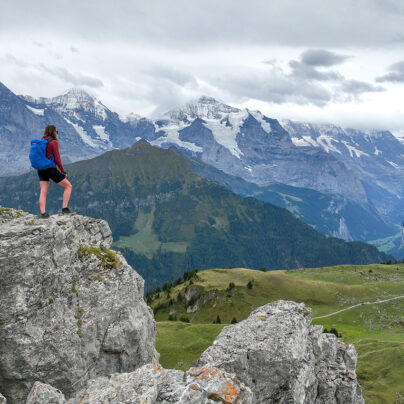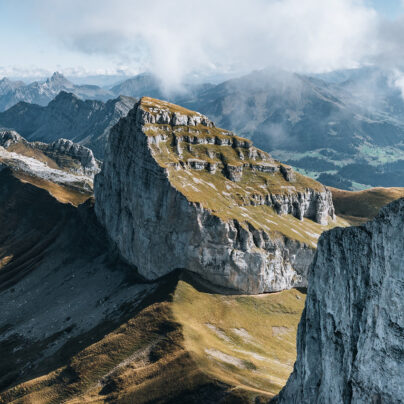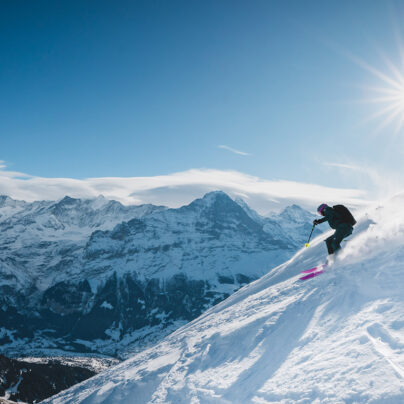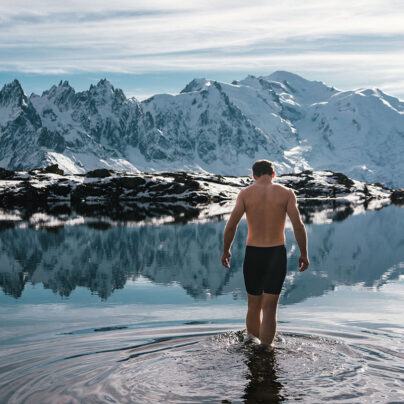Closing the Circle
Will Herman
I didn’t see the breaker until the last second, my attention entirely focused on a dark wall of water rapidly steepening to my left. Angling the bow away from the cliffs and turning into the wave, only an instinctive glance behind registered the greater threat. As the first wave passed under the bow it collided immediately with the second, rebounding from the cliffs. White-water cascaded over my shoulders as the hull surfed, carving one way and then another. I let out a whoop, part relief and part sheer joy – Sumburgh Head, whose mist-shrouded cliffs rose in muted charcoal tones above the clapotis, was proving to be everything it had promised.
The long swells steepened as we crossed the sound, yet by anyone’s standards, conditions were remarkably calm for such an exposed coastline. We cruised into Hamna Voe as the skies began to glow with the subtle hues of the mid-summer twilight. Later, walking on grassy slopes above a bouldery shore, I settled to watch the pastel skies darken above Foula on the western horizon.
Smooth seas and short nights
Setting off from Hamna Voe, a little south of Scalloway, the trip began with a short crossing of The Deeps to get established on the exposed west coast for the run up to Papa Stour. And so, after long months of anticipation, we reached the red cliffs of Skelda Ness in the early afternoon of our first full day’s paddling, exploring the many caves, tunnels and stacks of Silwick. Our time amidst this wild grandeur was brief – the urge to cover ground is always present on trips such as this – and before long we were pulling strongly past the Giltarump, a massive stack that marks the end of these gargantuan cliffs. We began crossing the wide bay towards Vaila and then Wats Ness where we had our first view north. The exposure of this remote coastline was evident everywhere – arches, stacks and skerries litter the base of the cliffs and we moved in, cutting as direct a line as we could between them. After 30km, we turned Pund Head and began to move off-shore again to avoid being swept into the Sound of Papa as we crossed to Papa Stour.
The long swells steepened as we crossed the sound, yet by anyone’s standards, conditions were remarkably calm for such an exposed coastline. We cruised into Hamna Voe as the skies began to glow with the subtle hues of the mid-summer twilight. Later, walking on grassy slopes above a bouldery shore, I settled to watch the pastel skies darken above Foula on the western horizon. A movement amongst the kelp caught my eye and I watched a family of otters move in quiet confidence below.
The unexpected calm remained in the morning as we continued north along what is arguably the finest stretch of coastline the British Isles has to offer a sea kayaker, allowing access to every cave, arch and tunnel that Papa Stour is famous for. And there was our dilemma. Our goal for the day was to clear the west coast, rounding the Point of Fethaland, still more than 50km away. It would mean crossing the wide expanse of St Magnus Bay, passing the bold headland of Eshaness and rounding the north-west corner before turning the Point of Fethaland itself; any of these sections of coastline would justify several days kayaking, but calm days like these bestow gifts that cannot be refused. We agreed to spend some time exploring the magnificent caves of Papa Stour before making a determined push north that afternoon. The west coast of Papa Stour culminates with the great bastion of Boardie, the headland which takes the brunt of the biggest swells from the northwest. And within these immense cliffs lies a tunnel 300m long – only three others anywhere in the world are known to be longer. In the calm conditions, we passed through easily enough, negotiating the mid-point dog-leg without difficulty, to emerge abruptly before the intimidating expanse of St Magnus Bay.
A quick confirmation of headings and bearings and we set off, a gentle north easterly wind on the bow quarter. To be so far off-shore on the open Atlantic, in a craft so small, is at once a daunting and breathtaking experience. As Papa Stour evaporated astern we paddled out across the giant bay, following the gannets wheeling gracefully above. Nearly three hours elapsed before the cliffs of Esha Ness suddenly grew in stature, their steep walls carved in intricate detail as we approached and landed in a small rocky bay to rest awhile before the next push north. We ate and eased stiff limbs in the warm, late afternoon sun, fuelling ourselves for another late finish.

Slipping into the Simmer Din
Crossing Ronas Voe, the moon was clearly visible while the evening light played across the red fluted cliffs of the Stonga Banks. Beyond, the pink granite of Ronas Hill – Shetland’s highest point – burned in the evening sun. Buoyed by the sight, I pulled strongly toward the stacks and skerries that marked our route north, on towards Uyea and the perfect sands that separate this charismatic island from North Roe and the mainland.
Sliding from golden sands into the cold northern seas again, we slipped into the Simmer Din as fulmars soared and the long beat of a gannet’s wings carried me west. Soon we drew close to the Ramna Stacks and in the twilight, passed the Point of Fethaland, our last headland of the day. Amongst the ruins of the fishing station we pitched the tents some 12 hours after launching. Papa Stour seemed a long way behind us but I knew it was likely we would face more challenging conditions tomorrow – a south-east swell had been rolling in for days now and a gale was forecast – but we had passed the first hurdle and, for the first time, I allowed myself to believe the weather and seas might just allow us to pass entirely around these wild shores. Sleep came quickly as the sea rose in the bay below, gentle waves washing the shingle in long, slow breaths that mirrored my own.
Beyond the bay, long swells rolled beneath our hulls. Although a few stronger gusts still rattled down the sound, the wind was now at a manageable F5, though it had shifted to the south-east, which, combined with a north-going tide, made for slow progress.
After a wet slog along dour cliffs, we began our crossing towards Yell, via Muckle Holm. As if on cue, the clag lifted and the mood changed. Ploughing through heavy seas, the rollers turned a deep blue, sparkling and surging against the island, iridescent greens cascading to mix with white foam beneath black rock. We covered just 25km that day, but it positioned us well for the next leg and at last, late that evening, the winds dropped. I settled back on the soft mossy grass beneath the tent, listening to the curlews sing as the tides shifted in the sound below.
Southerly swells and sleepy otters
An early start for this, our fourth day on the water, would make use of the strong tides for which the Sound of Yell is famed. The skies were clearing as the sun began to burn away the fog, and at Lunna Ness we met the south-easterly swell that would remain our constant companion for the rest of the trip. Pushing the pace, we reached Dury Voe in good time. Here the swell gathered to its full height, broad crests rolling towards the mainland. But the winds were light and the paddling a joy. The land here was different too – the morning’s fog replaced by soft sunshine on rolling hills; gentle greens and browns of the northern moorland blending beneath hazy skies.
Cruising in to the Wick of Ness, focused on the shingle beach ahead, I almost failed to see the otter. On the surface, in the calm of the bay behind Hogg Island, he seemed to be sleeping. As the bow passed overhead, he started, then watched for long seconds, until with a sudden flick and a roll, he was gone.
I woke suddenly to the wind – a roaring, violent thing that slammed against the tent walls – and the relentless hammering of rain. Later, unzipping the outer door I peered into a grey twilight, no division it seemed between land, sea or sky; just rushing spray, sea salt mixing with driving rain, blurred in a frenzy above the bay.
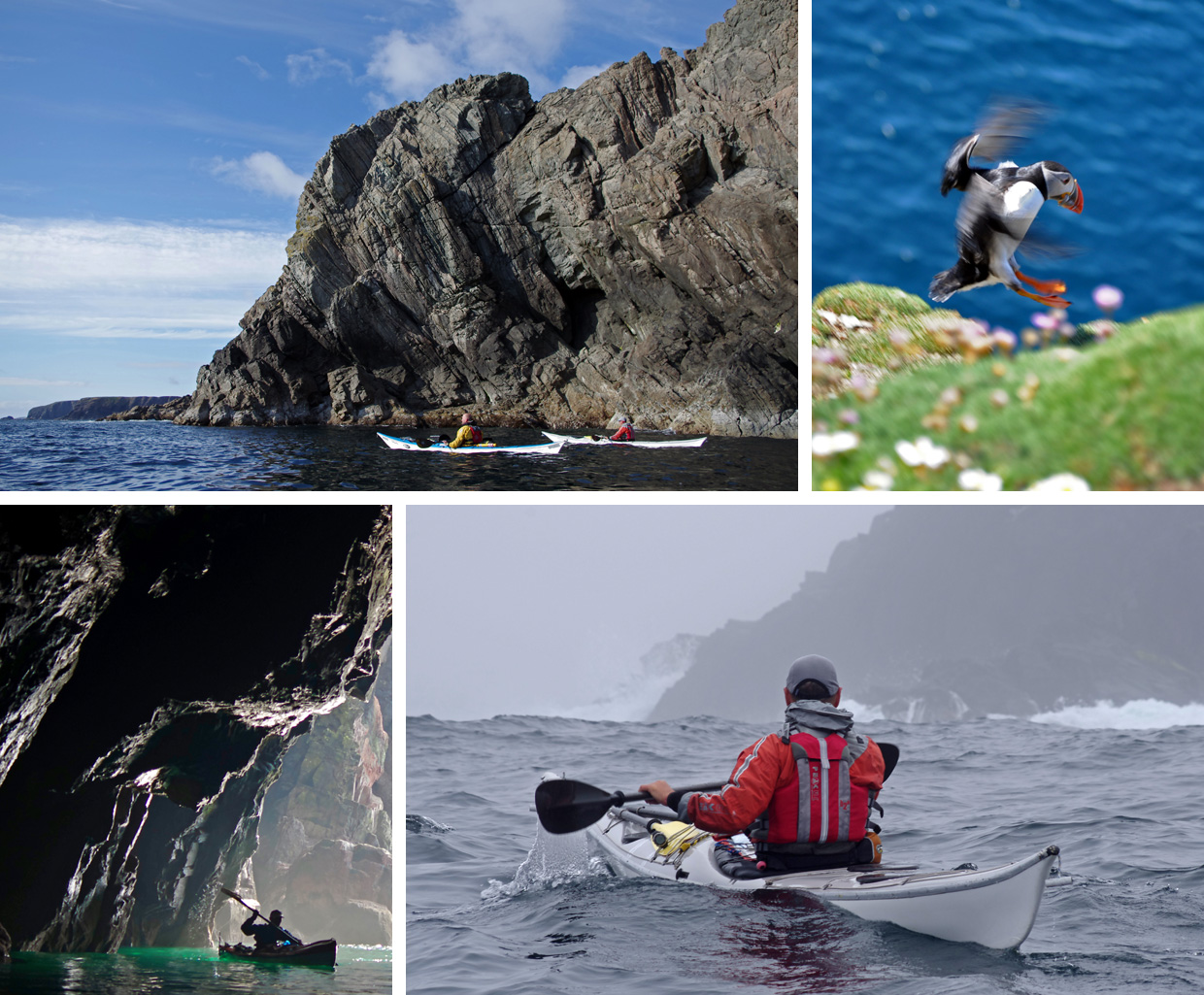
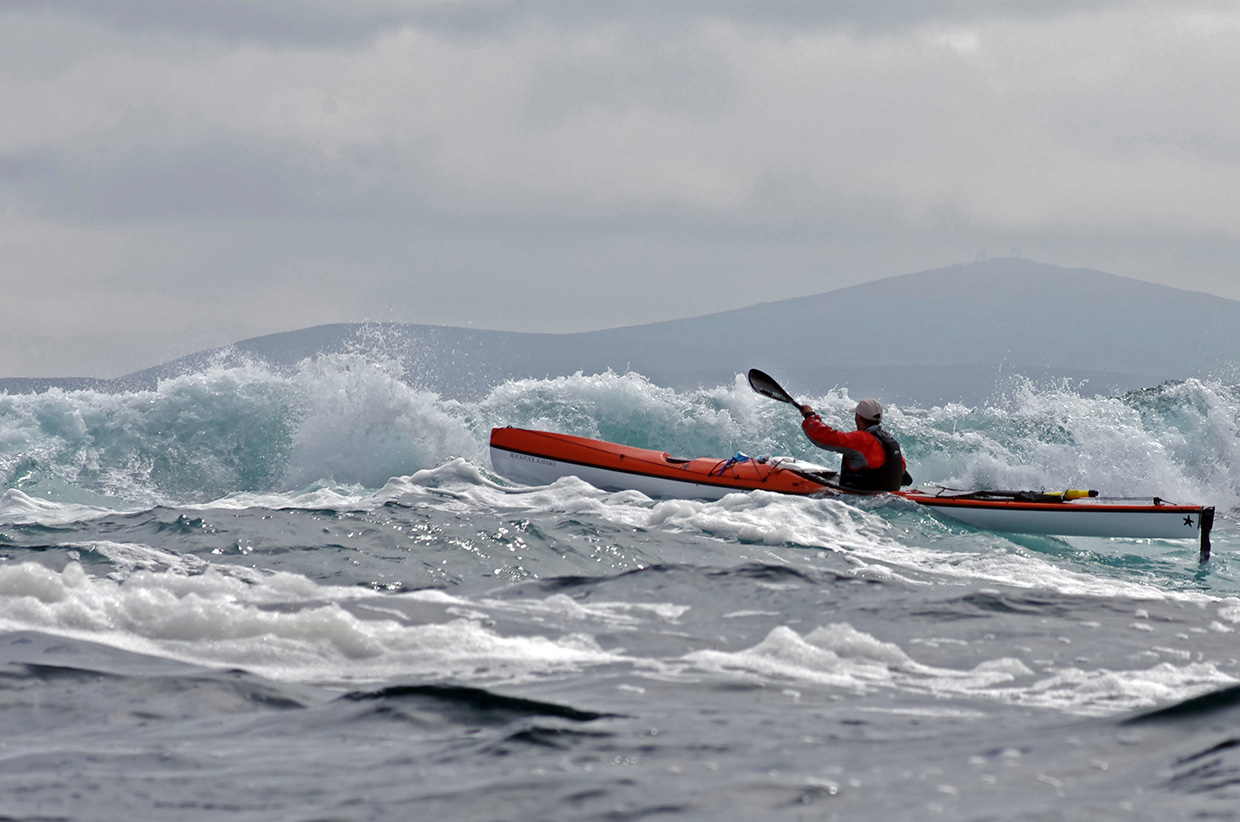
Back on the water, it was not long before things started to go wrong. Just a blister at first, but feeling cold and tired already, my mind drifted to warmer memories – standing on the headland beneath which we were paddling, watching as the Tall Ships sailed on a summer evening bound for Norway.
My focus had gone. I became annoyed as the others pulled ahead and I struggled to keep pace. I still hadn’t seen the warning signs and passing the small rugged headland, The Nizz, I headed out across Gulber Wick where the wind built quickly, funnelling from the higher ground between Run and Mossy Hill.
I could feel myself shutting down – cold, irrational and suddenly exhausted, I retreated to the tent. The sudden crash was a warning I should have heeded. But after some food and several cups of hot, sweet tea, I felt normal enough and began to check the route ahead.
I could see the others watching, waiting, and after what seemed an age I passed them by, unwilling to stop, plugging away into the East Voe of Quarff, to land eventually on the shingle at the back of the voe, exhausted, annoyed and confused.
Debate and decisions
I was dejected and angry at myself. I had been run down in the weeks before the trip and stubbornly ignored a cold just before we left, shivering in a down jacket as my companions swam in the cold seas. I simply needed rest and some good food. But with nowhere suitable to camp within the bay, and an unknown stretch of coast ahead where offshore winds would harry our progress, the decision was obvious. Overwhelmed by conflicting emotions, I thought our trip was over.
Two days later, my strength returned, we stood once again above the shingle at the Voe of Quarff. Feeling just a little foolish, I peered into the thick fog. Visibility was down to about 50m and a noticeable swell was breaking on the skerries, well within the sheltered confines of the bay. “A little rough for you today,” the local crofter had said. I didn’t want to reply to his implied question. I knew the response would be well meant, but I was committed now. It was time to get going.
From the East Voe of Quarff, we paddled in rising swells, culminating at Helli Ness where the jagged headland loomed amidst a shifting veil of spray and fog. Beyond, we were forced to paddle on a bearing, out of sight of land, to beach at the Wick of Sandsayre. In high spirits now, confident in our navigation and ability to cover the distance still to go, we set out on the 20km leg to Sumburgh. Crossings and headlands merged as we carved across swells and approaching Lambhoga Head the cliffs rose to greet us. The seas continued to build on the final approach to Sumburgh until thick swells were heaving beneath our hulls, colliding with the cliffs and crashing back out to sea. Bracing as a particularly violent wave broke over my shoulders, the hull carving one way and then another, I let out a whoop – part relief and part sheer joy at the wild scene through which we passed – Sumburgh Head, whose mist shrouded cliffs rose in dark muted tones above the clapotis, was proving to be everything it had promised.
Passing the final race at Horse Island, broad grins broke out as we realised we’d made it. It had been a long and committing section of paddling that had required constant concentration and a mistake here, at the end of the day, would have proved serious. Approaching Lady’s Holm, our camp for the night, the rain began to fall.
That night, as we steamed in sodden tents, wet gear hanging in porches, dripping amongst dry bags, we planned our final day, by phone – moving from the tents was out of the question. The misery of that wet night was allayed first by the satisfaction of rounding Sumburgh Head and then, by the building anticipation for what lay across the bay – Fitfull Head, a far more serious proposition than Sumburgh.

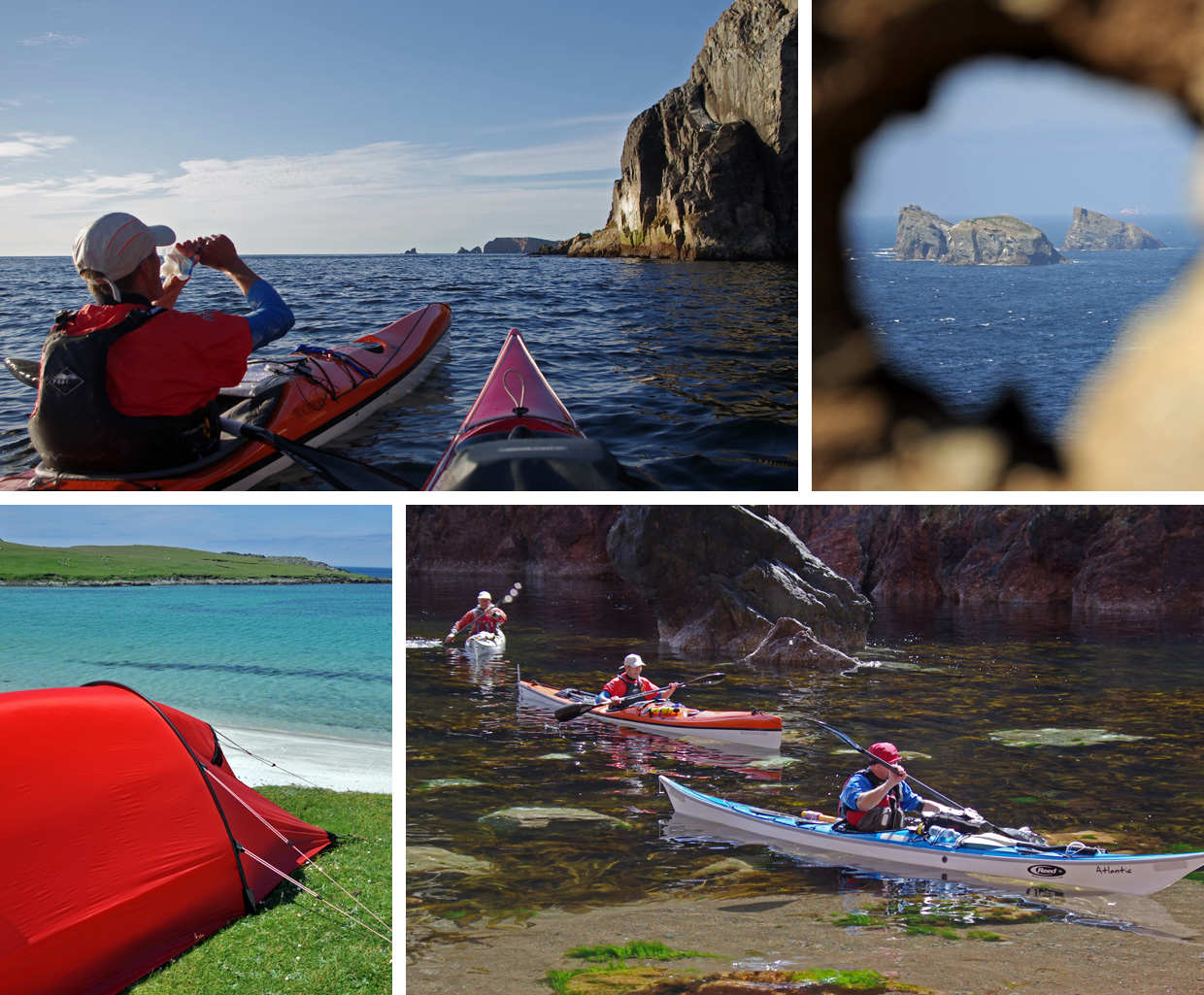

Fitfull Head – exposed, remote and utterly wild
Another early start, the day beginning once again with the unique sensation of pulling wet neoprene and damp base layers over cold skin, and we moved quickly with the tide towards the most awesome and intimidating sea cliffs I have ever seen. Jagged ridges cut high into a light mist and fresh scars of recent rock-fall divided the gothic buttresses beyond. Exposed, remote and utterly wild, Fitfull Head was beginning to make Sumburgh look tame and I was grateful that we were now shielded from the persistent south-easterly swell.
By the time we had reached Siggar Ness, the tide had turned and we eddy-hopped beneath the giant cliffs, in constant awe at the scale of our surroundings. Some distance away a fishing boat plunged through the race off-shore, disappearing completely before the bow rose suddenly only to plunge down again. For three kilometres we hugged the base of these dramatic cliffs, surfing against the flow through a final gap to round The Nev. Beyond, not a breath of wind stirred the bay. Impending cliffs loomed above while the silent deep turned green beneath our hulls. I leaned back and relaxed, letting out a long sigh.
Closing the Circle
The completion of our trip around Shetland Mainland meant different things to each of us, but for me, after many visits to the Northern Isles, I felt as though a very real circle in my life had been closed and a long held ambition fulfilled.
One of the abiding memories I will take from our time on Shetland – a vignette of our trip – is the concern of a local lady on that last afternoon at Hamna Voe, who watched as we systematically took over the parking lot. Unloading the boats, wet kit was hung from railings, damp sleeping bags draped across benches and all the paraphernalia that accompanies such a trip, laid out in the warm afternoon sun. Finally we pitched the tents loosely on a steep bank nearby, leaving them to dry. Unconcerned by the sight of our kit strewn haphazardly all around, or by the four rather dishevelled looking kayakers now sitting by a stove making a brew in the car park, her concern was directed at the unlikely looking nature of our sleeping arrangements. “But you can’t be comfortable there,” she said. “You’ll be sliding down the hill for sure.” Moments later she appeared with a plate laden with millionaire’s shortbread.

Will’s interest in sea kayaking was first as a means to reach remote sea cliffs to put up new routes – in fact, he enjoyed the sea kayaking so much that the climbing ended up taking a back seat for some years.
Still passionate about the mountains, Will’s spiritual home remains the Scottish Highlands and Islands and when he is not kayaking he will often be found carrying his bike to the summit of one mountain or another for a promising descent.
A freelance photographer and writer, Will is sponsored by Rockpool Kayaks and works full-time as a public relations consultant, specialising in the outdoor sector, with Pelican Communications.




